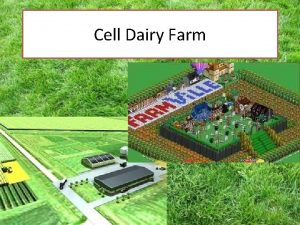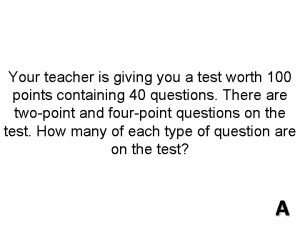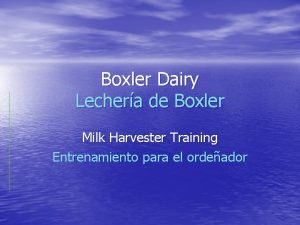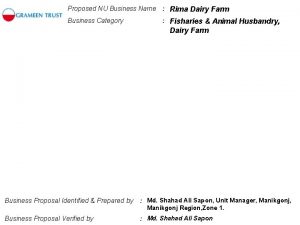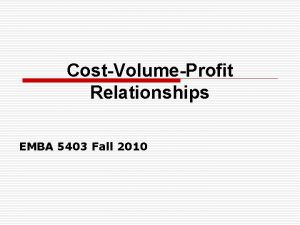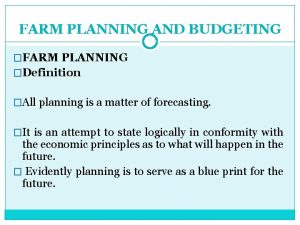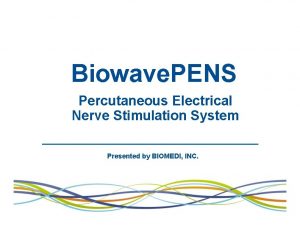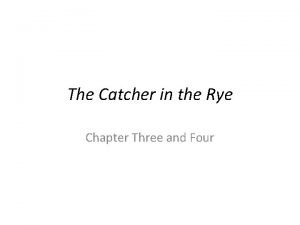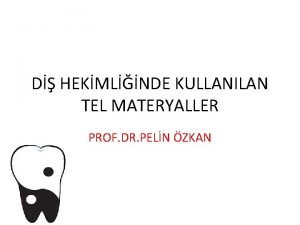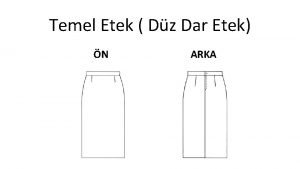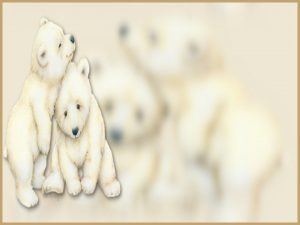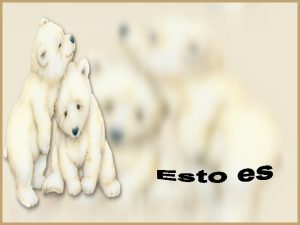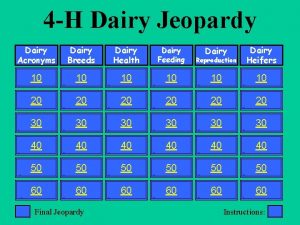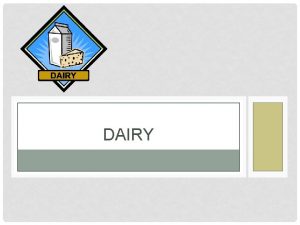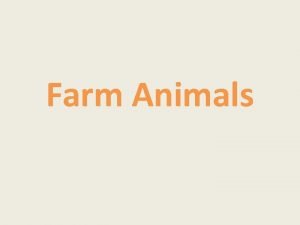Cell Dairy Farm 1 Pens and corrals The














- Slides: 14

Cell Dairy Farm

1. Pens and corrals • The endoplasmic reticulum (ER) is a series of interconnecting flattened tunnels which are attached to the outer membrane of the nucleus. The ER is the transport network for molecules targeted for certain modifications and specific final destinations.

2. Farm Gates • The cell membrane is found directly inside the cell wall in plants. It allows things to pass into and out of the cell. Materials like food and oxygen are kept inside the cell. Waste products and excess water are allowed to leave. In that way the cell can maintain correct conditions inside the cell regardless what the conditions may be outside the cell. This is known as a process called homeostasis.

3. Outer Fence • In a plant cell the cell wall is found outside the cell membrane. In an animal cell, the cell membrane forms the outer covering of the cell. • The cell wall is made of a tough material called cellulose and acts like a fence, keeping the cell safe from the environment. It forms a barrier between the living material inside the cell and the environment outside. • The cell wall also provides support for the cell. Animal cells, unlike plant cells, do not have a rigid cell wall.

4. Dairy Cows: • Ribosome – The ribosomes are found on the endoplasmic reticulum and floating in the cytoplasm. The ribosome is the protein factory of our cells. Without protein we wouldn't have cell membranes, enzymes, or substance in our bones, but the real construction site of the cell creates the ribosomes! Protein

5. Dairy Products Processing Plant: • Golgi Apparatus • The Golgi apparatus is a bit like a factory’s customization shop, where the finishing touches are put on products before they are ready to leave and “shipped” to their final destination. The Golgi apparatus attaches carbohydrates and lipids to them.

6. Solar Energy Panels • Chloroplasts, found only in plant cells, are green because they contain chlorophyll. Chlorophyll is what captures the energy of the sun, which can then be used to help produce food for the plant cell in the process of photosynthesis.

7. Farm Office: Nucleus The nucleus is the control center of the cell, acting like the "brain. " The nucleus is the largest organelle in a cell and can usually be seen using a light microscope. The nucleus contains the DNA of the cell - the genetic code which allows the cell to reproduce and which allows it to make all the proteins it needs to carry out the normal business of living.

8. Farm Records: • Nucleolus • Dense place inside the nucleus where the DNA is stored Farm Records

9. Fence Around Farm Office: • Nuclear Envelope

10. Dairy Manure Digester: • Mitochondria • The mitochondria are often called the 'power stations' of the cell. The reactions involved are very complex but, put very simply, the mitochondria burn food molecules to release energy. This energy is used by cells to do work. This work may be building new molecules which have a particular function in the body, or it may be to produce movement (muscle cells, for example). • They collect the methane given off by fermenting cow manure and use it to generate electricity. The procedure is relatively simple: manure is stored in huge tanks — anaerobic digesters — which are deprived of oxygen and kept at temperatures of 100°F. The conditions are designed to let anaerobic bacteria thrive and do the work of breaking the manure down. The large volume of "biogas" released — which contains about 90% methane — is piped to an engine which burns the gas and uses the heat energy to generate electricity. The leftover manure is compressed; fluid is drained away and used as fertilizer; and the solids are dried out and used as bedding for the herd and compost.

11. Tractor: • Lysosomes are small organelles filled with enzymes. Lysosomes also help break down organelles that outlived their usefulness. Lysosomes perform the vital function of removing debris that might otherwise accumulate and clutter up the cell.

12. Silo and Water Trough: • Vacuoles are used to transport and store nutrients, waste products and other molecules. The presence of a vacuole enables plant cells to grow larger than animal cells - the expansion of a fluid filled space is a lot less costly in terms of energy expenditure than expansion of a cell full of organellecontaining cytoplasm. Vacuoles are also used for storage of substances which the plant needs, but which may be toxic to the rest of the cell.

13. Pasture and Open Space • The cytoplasm consists of all of the contents outside of the nucleus and enclosed within the cell membrane of a cell.
 The outer fence of the plant cell
The outer fence of the plant cell Gabby and sydney bought some pens and pencils
Gabby and sydney bought some pens and pencils Boxler dairy farm
Boxler dairy farm Maghla nu
Maghla nu Dairy farm business names
Dairy farm business names Plinkets
Plinkets The doral company manufactures and sells pens
The doral company manufactures and sells pens What are the types of farm planning
What are the types of farm planning Four pens
Four pens Rufus woods net pens map
Rufus woods net pens map Biowave pens
Biowave pens Catcher in the rye chapter 3
Catcher in the rye chapter 3 Perodontal
Perodontal Kroşe pens
Kroşe pens Beden ölçü tablosu
Beden ölçü tablosu
